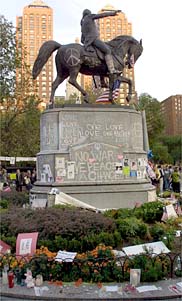
On September 11, 2001, the country and the world watched in horror as cataclysmic events unfolded in New York and Washington, D. C. For the first day or two, most people stayed glued to their television sets, talking about the events with those closest to them. Folk responses emerged immediately at the disaster sites themselves; for example, Manhattan's Union Square (right) quickly became an impromptu vigil, shrine, and bully pulpit for masses of New Yorkers needing to communicate with others about the events. But a widespread electronic folk response (in the form of formulaic and widespread e-mails) took awhile to develop.
Nevertheless, I received my first such e-mail message on September 12th, and quickly realized the significance of such communications: while joke cycles about tragic events are traditional, and have circulated both verbally and electronically in recent years, the World Trade Center and Pentagon disasters, as many commentators observed, were the first truly national disasters since the bombing of Pearl Harbor. Given the relatively recent advent of e-mail as a form of mass communication, how would that channel be used to respond to these events?
Other folklorists were speculating about such questions, and trying to collect such materials in any way possible; Bill Ellis, a folklorist at Pennsylvania State University, wonders about the timing and content of "disaster jokes" about 9/11 in an essay in the online journal New Directions in Folklore, while the Smithsonian Institution immediately dispatched a Call for Fieldwork to collect responses to the events.
Nearly fifty years earlier, the noted folklorist John Lomax had issued a similar call to collect Americans' responses to the attack on Pearl Harbor. To listen to some of the stories gathered through both calls for fieldwork, check out the wonderful streaming audio report from American Radioworks.
What's represented in this archive are e-mail messages I personally received, either spontaneously from friends, family, and colleagues, or messages I received in a more "solicited" manner--in other words, things people forwarded to me after I told them I was interested in collecting such things. While the vast majority of the items I received are included here, this is by no means a complete collection of the things I received, and it certainly only represents a fraction of the amount of e-lore that circulated related to these events. For the purposes of this archive, I've chosen the most visually interesting items, as well as the things that are representative of the kinds of materials I received in general.
Although I collected this information from a variety of sources, most of the material here comes from three primary groups of informants: UNC poet Lisa Zimmerman and her husband John Zimmerman, a native of New York State; folklore student and UNC graduate Tama Dean-Greenhagen (who did a collection project on 9/11 e-lore for her final project in my Fall 2001 Introduction to Folklore course); and the many folklorist colleagues on the NEWFOLK listserve, who sent copies of items they received to the list.
Before perusing the archives, some background information and explanation might be helpful. Please click on the links below for additional clarification:

| What is "e-lore"? | ||
Questions? Comments? Contributions? E-mail the site's creator, Rosemary Hathaway.
Read Rosemary's
article about this archive
in the Spring 2005 issue of the Journal
of Folklore Research